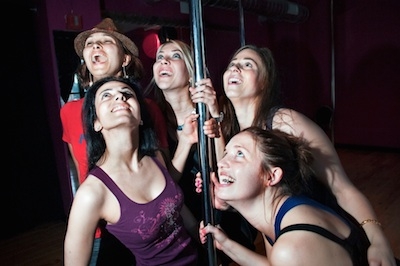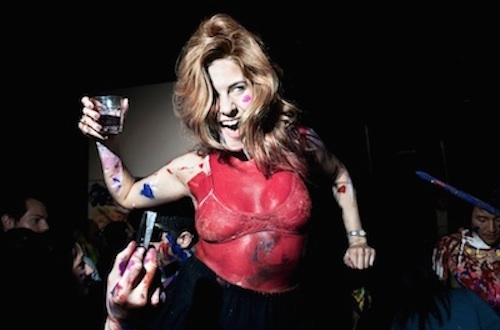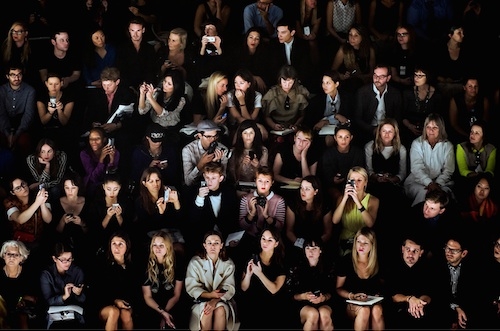Photographer Profile - Dina Litovsky: "I ask more questions than I answer"

|
|
|
Litovsky came to this understanding in 2010, when she took her camera into New York City nightclubs. At the time, she was finishing a masters program at the School of Visual Arts and needed to complete a thesis project. The work she had been doing—she calls it “pseudo-conceptual black-and-white stuff”—had been rejected three months before graduation. But when her advisor saw some photographs Litovsky had made earlier in the program at a number of bachelorette parties, she was intrigued. “She said, ‘This is what you should be doing,’" recalls Litovsky.
The images of the bachelorette parties presented a startling, intimate view of modern young women within the context of sexually charged celebrations in which men were absent. Litovsky thought it might prove interesting to take a similar approach by observing women and men partying together in New York City. “So the next weekend I headed out to the clubs,” she says.
At first, she thought she might meet some resistance when she showed up with a camera and flash, but was surprised by what she found. A few years before, she says, she wouldn’t even have been allowed inside. “I started going to clubs when I was 18, and then there was more of a sex-club vibe,” she says. Now everyone inside the clubs had camera phones, and the sex-club vibe had turned into an exhibitionist vibe.
“The cameras took over the space,” she says. Litovsky was particularly struck by how women at the clubs performed for the cameras. “They were dancing for this audience of photographers,” she says. “The cameras were like mirrors, or the male gaze that the girls wanted to attract.”
Emerging Talent
The series of images that Litovsky ended up making, which she titled “Untag This Photo,” not only satisfied her MFA thesis requirement but also launched her on a photography career and helped her earn a reputation as one of the brightest young talents of the decade. The nightclub photos have been featured widely online, as have photographs from her series on bachelorette parties. Litovsky has been singled out at the Eddie Adams workshops, won an NPPA Best of Photojournalism award and shot editorial work for a number of publications, most notably New York magazine, which assigned her to cover fashion shows in New York, Paris and London.
Last year, Litovsky was included in Photo District News’s annual list of important emerging photographers. Now she is one of 90 photographers from the PDN list featured in "Emerging," an exhibition opening on June 6 at the Annenberg Space for Photography. Besides being featured in a documentary created for the show, Litovsky will be speaking there on June 18.
“Her work, both editorial and fine-art projects, has a distinctive look, not just because of her visual style, but because of her point of view,” says Amy Wolf, photo editor of Photo District News.

In her nightclub project, Litovsky captures the age of exhibitionism dramatically, through the use of an off-camera flash that isolates her subjects from the background and a 28mm lens that requires her to get close to her subjects. Her pictures are lurid color versions of the sensual black-and-white photographs of society balls shot in the 1970s by photographer Larry Fink, who Litovsky cites as one of her influences.
Like Fink, Litovsky manages to combine derision, insight, and empathy in her work. Both photographers reveal an understanding of human nature: Fink once described his subjects’ desire to be photographed as a “compulsion for proof.” Litovsky talks about women participating “more than ever in their own objectification.”
“Dina has an innate curiosity that leads her to pull emotionally charged tableaux out of crowds,” says Emily Shornick, the photo editor of New York’s fashion blog The Cut, who first saw Litovsky’s work while looking through SVA portfolios and later assigned her to cover fashion shows. “What really sold me was the way she was looking at women. It would be so easy to photograph in nightlife environments and make images that shame women for presenting their sexuality. Dina’s gaze is much more complicated. She photographs an honest sexuality not with judgment or with desire, but with reverence.”
Exploring Human Behavior
Litovsky, who was born in the Ukraine, honed her observation skills while growing up in New York City. “[E]verything that I photograph is still from the point of view of the outsider,” she told one interviewer. She went on to study psychology at New York University, and after graduation thought about medical school. That was followed by what she later described as “a feeling of dread.” Instead of med school she bounced around for three years, “not really doing much,” she says. Her parents gave her a camera, and she started photographing obsessively. Eventually, she found that she could combine her background in psychology with her interest in photography, so she took the next step and enrolled at SVA.
“I really loved studying psychology, and I’m fascinated by social interaction and social behavior, but I found that I could actually explore those subjects more with a camera than I could by just doing research and reading about them,” she says.

Her background in psychology certainly informs her photography. In her artist’s statement for “Untag This Photo,” she writes that “the desire to reveal has transformed into a willingness to expose.” Digital cameras and social media have only intensified that urge, she notes.
Her photographs of fashion shows, featured earlier this year in a solo exhibition at New York’s Anastasia gallery called “Fashion Lust,” reveal the same culture of self-display. “The fashion shows sustain the narcissism I saw in the clubs, but it’s amplified,” she says. “For me, fashion week was like ‘Untagged’ on steroids.”
Throughout all her work, Litovsky works around one of photography’s central themes, the relationship between exhibitionism and voyeurism, an interplay made mutually satisfying by the camera. The iPhone and Facebook have made the accord between the watcher and watched more complex, since everyone is now both. “My photographs really ask more questions than they answer,” says the former psychology student.


